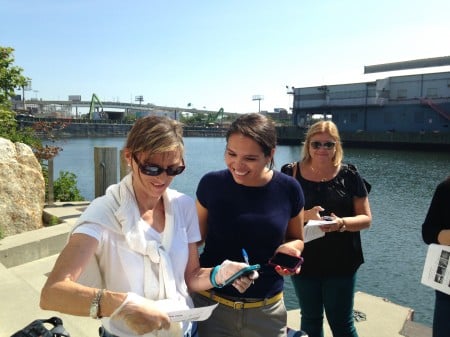Riverkeeper and HSBC Visit Newtown Creek

View more images on our Flickr site
Riverkeeper and the HSBC Water Programme visited Newtown Creek in August. HSBC Water Programme is a generous funder of Riverkeeper’s water quality program, which tests the Hudson River estuary and watershed monthly at more than 180 locations, with the help of citizen scientists. HSBC also coordinates its own employees in a citizen science water quality monitoring program called FreshWaterWatch.
On August 19, when HSBC employees sampled water, the Newtown Creek had very clear water, with little sign of contamination by Enterococcus. Riverkeper’s own tests of the Newtown Creek on August 11 also showed very low levels of bacteria at the Metropolitan Avenue Bridge and the Dutch Kills tributary.
In dry weather, the city’s largest sewage treatment plant, with its distinctive sparkling egg-shaped digesters, does its job of cleaning the city’s wastewater, as we learned on a tour of the plant. New York City Department of Environmental Conservation staff had some tips for citizens: Don’t dump grease or “flushable” wipes down the toilet. Both should go in the trash, as they create expensive and polluting clogs in the system.
Riverkeeper’s testing at 15 locations around New York City show that good water in dry weather is a familiar pattern. But in wet weather, the change is dramatic. The Newtown Creek alone has 23 combine sewer outfalls, and receives up to 1.5 billion gallons a year of streetwater and sewage that enter the creek before the wastewater can reach the treatment plant.
An arm of the Hudson River estuary, Newtown Creek suffers from more than just sewage overflows. Riverkeeper first patrolled the creek in 2002, and found that a massive oil spill–which turned out to be the largest of its kind in state history–was seeping into the creek. A lawsuit followed, and ultimately led to a settlement with ExxonMobil for a stop to the seepage, a longterm cleanup plan, and $19.5 million for environmental benefit projects to be selected with the help of a community group Riverkeeper helped to form, the Newtown Creek Alliance.
The Environmental Protection Agency is developing a comprehensive Superfund cleanup plan for the range of contaminants that contaminate the creek, which was an ecologically productive tidal marsh before it became an industrial backwater. And the city is developing a long term control plan for its combined sewer overflows which will include green infrastructure demonstration projects in the Newtown Creek sewershed. Yes, sewershed. With so much of the tidal creek’s watershed now paved over, most water flowing into the creek is from street runoff and sewer discharges.
Photos by Dan Shapley / Riverkeeper






